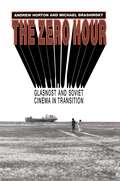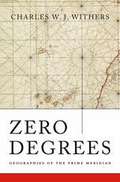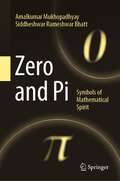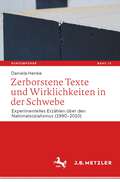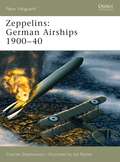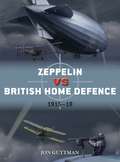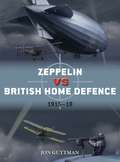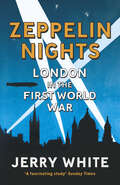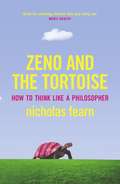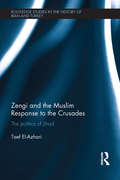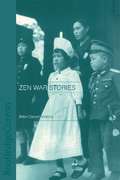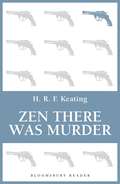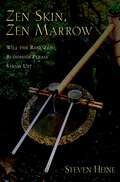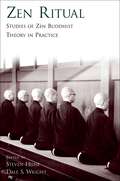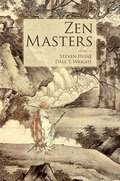- Table View
- List View
The Zero Hour: Glasnost and Soviet Cinema in Transition
by Andrew Horton Michael BrashinskyNow faced with the "zero hour" created by a new freedom of expression and the dramatic breakup of the Soviet Union, Soviet cinema has recently become one of the most interesting in the world, aesthetically as well as politically. How have Soviet filmmakers responded to the challenges of glasnost? To answer this question, the American film scholar Andrew Horton and the Soviet critic Michael Brashinsky offer the first book-length study of the rapid changes in Soviet cinema that have been taking place since 1985. What emerges from their collaborative dialogue is not only a valuable work of film criticism but also a fascinating study of contemporary Soviet culture in general. Horton and Brashinsky examine a wide variety of films from BOMZH (initials standing for homeless drifter) through Taxi Blues and the glasnost blockbuster Little Vera to the Latvian documentary Is It Easy to Be Young? and the "new wave" productions of the "Wild Kazakh boys." The authors argue that the medium that once served the Party became a major catalyst for the deconstruction of socialism, especially through documentary filmmaking. Special attention is paid to how filmmakers from 1985 through 1990 represent the newly "discovered" past of the pre-glasnost era and how they depict troubled youth and conflicts over the role of women in society. The book also emphasizes the evolving uses of comedy and satire and the incorporation of "genre film" techniques into a new popular cinema. An intriguing discussion of films of Georgia, Estonia, Latvia, Lithuania, and Kazakhstan ends the work.
Zero Degrees: Geographies of the Prime Meridian
by Charles W. WithersCharles Withers explains how the choice of Greenwich to mark 0° longitude solved problems of global measurement that had engaged geographers, astronomers, and mariners since ancient times. This history is a testament to the power of maps, the challenges of global measurement, and the role of scientific authority in creating the modern world.
Zero Degrees: Geographies of the Prime Meridian
by Charles W. WithersCharles Withers explains how the choice of Greenwich to mark 0° longitude solved problems of global measurement that had engaged geographers, astronomers, and mariners since ancient times. This history is a testament to the power of maps, the challenges of global measurement, and the role of scientific authority in creating the modern world.
Zero and Pi: Symbols of Mathematical Spirit
by Amalkumar Mukhopadhyay Siddheshwar Rameshwar BhattThe book, divided into two major parts, discusses the evolution of the concept and symbols of zero and the history of pi. Both the topics are discussed from the Neolithic Age to the nineteenth century. The book also clears the assumption that Johann Heinrich Lambert (AD 1761) only invented the irrationality of pi by crediting Lambert jointly with André Marie Legendre (AD 1794).Part 1, consisting of six stages spread in six chapters, meets a challenge to the authors as eminent scholars of the history of mathematics have diverse opinions based on conjectures. This part primarily discusses how the symbol O, in the Vedic religious practices, considered a replica of the universe prescribed for meditation on the unknown Brahman (conceived of as the space supreme in the Upanishads), was later transcended to the symbol of an unknown quantity in mathematics along with a dot for zero in an arena of atheism. It also highlights how the zero notation and the decimal system of Indian numerals embellished with the algebraic thoughts of Brahmagupta passed on to China and Europe via Arabia. Topics in this part have traced the development from the origin to the final form as seen today after the western practice and try to put an end to the long-standing debate over history. Appendices contain the Sanskrit verses (transliterated with meanings into English) along with the essential mathematical deduction referred to in the body of the part to help the reader to have a better understanding.Part 2 speaks of a novel idea of unveiling the nature of pi interwoven with threads of historical ups and downs in the world scenario. This part, containing five chapters, collects all available up-to-date data in every field of history to make the presentation complete in all respects. This part discusses the origin of the definition of pi as the rim of a wheel is thrice its diameter at the Indus Valley in the fourth millennium BC. This part also discusses the enlightenment of China in circle-squaring (classical method), Indian mathematics with astronomical knowledge along the Buddhist channel, and India’s discovering circumference/diameter as a non-Euclidean number.
Zerborstene Texte und Wirklichkeiten in der Schwebe: Experimentelles Erzählen über den Nationalsozialismus (1990–2010) (Kontemporär. Schriften zur deutschsprachigen Gegenwartsliteratur #13)
by Daniela HenkeExperimentelle Texte über Holocaust und Nationalsozialismus fallen durch ein Forschungsraster. Durch ihre sperrige Form entziehen sie sich den Kategorien der memory studies – wegen ihrer brisanten Thematik sind sie ungeeignet für das rein formale Erkenntnisinteresse der klassischen Narratologie. Getragen von der Idee, dass Erzählformen selbst erzählen, verfolgt diese Untersuchung zwei Ziele. Zunächst wird eine allgemeine Typologie experimentellen Erzählens entworfen. Darauf folgen Analysen von Erzähltexten der Gegenwartsliteratur: Heldenfriedhof von Thomas Harlan, Morbus Kitahara von Christoph Ransmayr, Nahe Jedenew von Kevin Vennemann, Harlem Holocaust von Maxim Biller und Frühling von Thomas Lehr. Im Mittelpunkt stehen dabei die Funktionen experimentellen Erzählens mit Blick auf den ‚Undarstellbarkeitstopos‘ in seinen verschiedenen Variationen.
Zeppelins: German Airships 1900–40 (New Vanguard)
by Ian Palmer Charles StephensonOn 2 July 1900 the people of Friedrichshafen, Germany, witnessed a momentous occasion the first flight of LZ 1, Count Ferdinand von Zeppelin's first airship. Although deemed a failure, a succession of better craft (LZ2 to 10) enabled the Zeppelin to expand into the consumer market of airship travel, whilst also providing military craft for the German Army and Navy. The years of the Great War saw the Zeppelins undertake strategic bombing missions against Great Britain. This title covers the post-war fate of the Zeppelins, including the crash of the Hindenburg, and their use by the Luftwaffe at the beginning of World War II.
Zeppelins: German Airships 1900–40 (New Vanguard #101)
by Charles Stephenson Mr Ian PalmerOn 2 July 1900 the people of Friedrichshafen, Germany, witnessed a momentous occasion the first flight of LZ 1, Count Ferdinand von Zeppelin's first airship. Although deemed a failure, a succession of better craft (LZ2 to 10) enabled the Zeppelin to expand into the consumer market of airship travel, whilst also providing military craft for the German Army and Navy. The years of the Great War saw the Zeppelins undertake strategic bombing missions against Great Britain. This title covers the post-war fate of the Zeppelins, including the crash of the Hindenburg, and their use by the Luftwaffe at the beginning of World War II.
Zeppelin vs British Home Defence 1915–18 (Duel)
by Jim Laurier Jon GuttmanWhen Ferdinand Graf von Zeppelin's rigid airship LZ 1 flew over Lake Constance in 1900, it was the most advanced and impressive flying machine in the world: a colossal, lighter-than-air craft capable of controlled flight. In World War I, Zeppelins were first used in a reconnaissance role, but on 19 January 1915 Kaiser Wilhelm II authorised their use in bombing strategic targets in England. From then on, 'Zeppelin' became synonymous with terror to the British, and indeed the airship's effectiveness was more psychological than material. Still, their raids compelled the Royal Flying Corps and Royal Naval Air Service to embark on a program of modernising their aerial defences, accelerating a process that would ultimately make the aeroplane, rather than the airship, the paramount flying machine of the war. Using specially commissioned artwork, contemporary photographs and first-hand accounts, this book tells the fascinating story of Britain's first Blitz, from the airships who terrorised the public to the men who sought to defend the skies.
Zeppelin vs British Home Defence 1915–18 (Duel #85)
by Jim Laurier Jon GuttmanWhen Ferdinand Graf von Zeppelin's rigid airship LZ 1 flew over Lake Constance in 1900, it was the most advanced and impressive flying machine in the world: a colossal, lighter-than-air craft capable of controlled flight. In World War I, Zeppelins were first used in a reconnaissance role, but on 19 January 1915 Kaiser Wilhelm II authorised their use in bombing strategic targets in England. From then on, 'Zeppelin' became synonymous with terror to the British, and indeed the airship's effectiveness was more psychological than material. Still, their raids compelled the Royal Flying Corps and Royal Naval Air Service to embark on a program of modernising their aerial defences, accelerating a process that would ultimately make the aeroplane, rather than the airship, the paramount flying machine of the war. Using specially commissioned artwork, contemporary photographs and first-hand accounts, this book tells the fascinating story of Britain's first Blitz, from the airships who terrorised the public to the men who sought to defend the skies.
Zeppelin Nights: London in the First World War
by Jerry WhiteA Guardian Best Book of the Year 201411pm, Tuesday 4 August 1914: with the declaration of war London becomes one of the greatest killing machines in human history. Hundreds of thousands of soldiers pass through the capital on their way to the front; wounded men are brought back to be treated in London’s hospitals; and millions of shells are produced in its factories. The war changes London life for ever. Women escape the drudgery of domestic service to work as munitionettes. Full employment puts money into the pockets of the London poor for the first time. Self-appointed moral guardians seize the chance to clamp down on drink, frivolous entertainment and licentious behaviour. As the war drags on, gloom often descends on the capital. And at night London is plunged into darkness for fear of German bombers and Zeppelins that continue to raid the city. Yet despite daily casualty lists, food shortages and enemy bombing, Londoners are determined to get on with their lives and flock to cinemas and theatres, dance halls and shebeens, firmly resolved not to let Germans or puritans spoil their enjoyment. Peopled with patriots and pacifists, clergymen and thieves, bluestockings and prostitutes, Jerry White’s magnificent panorama reveals a struggling yet flourishing city.
Zeppelin Blitz: The German Air Raids on Great Britain During the First World War
by Neil R. StoreyIn 1907, H.G. Wells published a science fiction novel called The War in the Air. It proved to be portentous. In the early years of the First World War, German lighter-than-air flying machines, Zeppelins, undertook a series of attacks on the British mainland. German military strategy was to subdue Britain, both by the damage these raids caused and by the terrifying nature of the craft that carried them out. This strategy proved successful. The early raids caused significant damage, many civilian casualties and provoked terror and anger in equal measure. But the British rapidly learnt how to deal with these futuristic monsters. A variety of defence mechanisms were developed: searchlights, guns and fighter aircraft were deployed, the British learnt to pick up the airships’ radio messages and a central communications headquarters was set up. Within months aerial strategy and its impact on the lives of civilians and the course of conflict became part of human warfare. As the Chief of the Imperial German Naval Airship Division, Peter Strasser, crisply put it: ‘There is no such thing as a non-combatant any more. Modern war is total war.’ Zeppelin Blitz is the first full, raid-by-raid, year-by-year account of the Zeppelin air raids on Britain during the First World War, based on contemporary official reports and documents.
Zentralasien und die Seidenstraße: Wirtschaftlicher Aufschwung und Niedergang über mehrere Jahrtausende
by Stephan BarisitzDieses Buch bietet einen umfassenden Überblick über die vormoderne Wirtschaftsgeschichte Zentralasiens und der Seidenstraße, die mehrere Jahrtausende umfasst. Durch die Analyse einer Fülle von Quellen und Materialien veranschaulicht es die wiederholten wirtschaftlichen Blütezeiten der Seidenstraße, in denen sie über viele Jahrhunderte Orient und Okzident verband. Nomadische Steppenreiche beherrschten häufig Zentralasien, prägten dessen Wirtschaft und beeinflussten den Handel entlang der Seidenstraße. Das Buch untersucht die Ursachen und Auswirkungen des weitreichenden Booms des Überlandhandels und erörtert gleichzeitig verschiedene interne und externe Faktoren, die zum allmählichen wirtschaftlichen Niedergang Zentralasiens und letztlichzum Ende der Seidenstraße führten. Schließlich wird erläutert, wie der wirtschaftliche Niedergang zum chinesischen und russischen Kolonialismus im 18. und 19. Jahrhundert beitrug. Detaillierte Informationen, z.B. über den Verlauf der Seidenstraße in den verschiedenen Epochen, werden in Form zahlreicher neu erstellter Karten angeboten.
Zenobia: Shooting Star of Palmyra (Women in Antiquity)
by Nathanael AndradeHailing from the Syrian city of Palmyra, a woman named Zenobia (also Bathzabbai) governed territory in the eastern Roman empire from 268 to 272. She thus became the most famous Palmyrene who ever lived. But sources for her life and career are scarce. This book situates Zenobia in the social, economic, cultural, and material context of her Palmyra. By doing so, it aims to shed greater light on the experiences of Zenobia and Palmyrene women like her at various stages of their lives. Not limiting itself to the political aspects of her governance, it contemplates what inscriptions and material culture at Palmyra enable us to know about women and the practice of gender there, and thus the world that Zenobia navigated. It reflects on her clothes, house, hygiene, property owning, gestures, religious practices, funerary practices, education, languages, social identities, marriage, and experiences motherhood, along with her meteoric rise to prominence and civil war. It also ponders Zenobia's legacy in light of the contemporary human tragedy in Syria.
Zenobia: Shooting Star of Palmyra (Women in Antiquity)
by Nathanael AndradeHailing from the Syrian city of Palmyra, a woman named Zenobia (also Bathzabbai) governed territory in the eastern Roman empire from 268 to 272. She thus became the most famous Palmyrene who ever lived. But sources for her life and career are scarce. This book situates Zenobia in the social, economic, cultural, and material context of her Palmyra. By doing so, it aims to shed greater light on the experiences of Zenobia and Palmyrene women like her at various stages of their lives. Not limiting itself to the political aspects of her governance, it contemplates what inscriptions and material culture at Palmyra enable us to know about women and the practice of gender there, and thus the world that Zenobia navigated. It reflects on her clothes, house, hygiene, property owning, gestures, religious practices, funerary practices, education, languages, social identities, marriage, and experiences motherhood, along with her meteoric rise to prominence and civil war. It also ponders Zenobia's legacy in light of the contemporary human tragedy in Syria.
Zeno and the Tortoise: How To Think Like A Philosopher
by Nicholas FearnA witty and irreverent guide to the key ideas and methods of the world's greatest thinkers.Zeno and the Tortoise explains not just who each philosopher was and what he thought, but exactly how he came to think in the way that he did. Nicholas Fearn presents philosophy as a collection of tools - from Ockham's Razor to Hume's Fork - each of which can be brought to bear on any number of predicaments. Written in twenty-five short chapters, each readable during the journey to work, Zeno and the Tortoise is an ideal course in intellectual self-defence.
Zennor in Darkness: From the Women’s Prize-Winning Author of A Spell of Winter
by Helen DunmoreIn her prize-winning first novel, Zennor in Darkness, Helen Dunmore reimagines the plight of D.H. Lawrence and his German wife hiding out in Cornwall during the First World War. Spring, 1917, and war haunts the Cornish coastal village of Zennor: ships are being sunk by U-boats, strangers are treated with suspicion, and newspapers are full of spy stories. Into this turmoil come D. H Lawrence and his German wife, Frieda hoping to escape the war-fever that grips London. They befriend Clare Coyne, a young artist struggling to console her beloved cousin, John William, who is on leave from the trenches and suffering from shell-shock.Yet the dark tide of gossip and innuendo means that Zennor is neither a place of recovery nor of escape . . .'Helen Dunmore mesmerizes you with her magical pen' Daily Mail'A beautiful and inspired novel' John le Carré'Secrets, unspoken words, lies that have the truth wrapped up in them somewhere make Dunmore's stories ripple with menace and suspense' Sunday TimesHelen Dunmore has published eleven novels with Penguin: Zennor in Darkness, which won the McKitterick Prize; Burning Bright; A Spell of Winter, which won the Orange Prize; Talking to the Dead; Your Blue-Eyed Boy; With Your Crooked Heart; The Siege, which was shortlisted for the 2001 Whitbread Novel of the Year Award and for the Orange Prize for Fiction 2002; Mourning Ruby; House of Orphans; Counting the Stars and The Betrayal, which was longlisted for the Man Booker Prize 2010. She is also a poet, children's novelist and short-story writer.
Zengi and the Muslim Response to the Crusades: The politics of Jihad (Routledge Studies in the History of Iran and Turkey)
by Taef El-AzhariZengi gained his legacy as the precursor to Saladin. While Zengi captured Edessa, Saladin would capture Jerusalem, and both leaders fought to establish their own realms. However, Zengi cannot be fully understood without an examination of his other policies and warfare and an appreciation of his Turkmen background, all of which influenced his fight against the Crusades. Zengi and the Muslim Response to the Crusades: The politics of Jihad, provides a full and rich picture of Zengi’s career: his personality and motives; his power and ambition; his background and his foundation of a dynasty and its contribution, along with other dynasties, to a wider, deeper Turkification of the Middle East; his tools and methods; his vision, calamities and achievements; and how he was perceived by his contemporaries and modern scholars. Examining primary Muslim and non-Muslim sources, this book’s extensive translations of original source material provides new insight into the complexities of Zengi’s rule, and the politics of jihad that he led and orchestrated during the Crusades. Providing deeper understanding of Islamic history through a close examination of one of its key figures, this book will be a valuable resource for students and scholars interested in Muslim history and the Crusades in general.
Zengi and the Muslim Response to the Crusades: The politics of Jihad (Routledge Studies in the History of Iran and Turkey)
by Taef El-AzhariZengi gained his legacy as the precursor to Saladin. While Zengi captured Edessa, Saladin would capture Jerusalem, and both leaders fought to establish their own realms. However, Zengi cannot be fully understood without an examination of his other policies and warfare and an appreciation of his Turkmen background, all of which influenced his fight against the Crusades. Zengi and the Muslim Response to the Crusades: The politics of Jihad, provides a full and rich picture of Zengi’s career: his personality and motives; his power and ambition; his background and his foundation of a dynasty and its contribution, along with other dynasties, to a wider, deeper Turkification of the Middle East; his tools and methods; his vision, calamities and achievements; and how he was perceived by his contemporaries and modern scholars. Examining primary Muslim and non-Muslim sources, this book’s extensive translations of original source material provides new insight into the complexities of Zengi’s rule, and the politics of jihad that he led and orchestrated during the Crusades. Providing deeper understanding of Islamic history through a close examination of one of its key figures, this book will be a valuable resource for students and scholars interested in Muslim history and the Crusades in general.
Zen War Stories (Routledge Critical Studies in Buddhism)
by Brian VictoriaFollowing the critically acclaimed Zen at War (1997), Brian Victoria explores the intimate relationship between Japanese institutional Buddhism and militarism during the Second World War.Victoria reveals for the first time, through examination of the wartime writings of the Japanese military itself, that the Zen school's view of life and death was deliberately incorporated into the military's programme of 'spiritual education' in order to develop a fanatical military spirit in both soldiers and civilians. Furthermore, that D. T. Suzuki, the most famous exponent of Zen in the West, is shown to have been a wartime proponent of this Zen-inspired viewpoint which enabled Japanese soldiers to leave for the battlefield already resigned to death. Victoria takes us onto the naval battlefield in the company of warrior-monk and Rinzai Zen Master Nakajima Genjô. We view the war in China through the eyes of a Buddhist military chaplain. The book also examines the relationship to Buddhism of Japan's seven Class-A war criminals who were hung by the Tokyo War Crimes Tribunal in 1948.A highly controversial study, this book will be of interest, first and foremost, to students of Zen as well as all those studying the history of this period, not to mention anyone concerned with the perennial question of the 'proper' relationship between religion and the state.
Zen War Stories (Routledge Critical Studies in Buddhism)
by Brian VictoriaFollowing the critically acclaimed Zen at War (1997), Brian Victoria explores the intimate relationship between Japanese institutional Buddhism and militarism during the Second World War.Victoria reveals for the first time, through examination of the wartime writings of the Japanese military itself, that the Zen school's view of life and death was deliberately incorporated into the military's programme of 'spiritual education' in order to develop a fanatical military spirit in both soldiers and civilians. Furthermore, that D. T. Suzuki, the most famous exponent of Zen in the West, is shown to have been a wartime proponent of this Zen-inspired viewpoint which enabled Japanese soldiers to leave for the battlefield already resigned to death. Victoria takes us onto the naval battlefield in the company of warrior-monk and Rinzai Zen Master Nakajima Genjô. We view the war in China through the eyes of a Buddhist military chaplain. The book also examines the relationship to Buddhism of Japan's seven Class-A war criminals who were hung by the Tokyo War Crimes Tribunal in 1948.A highly controversial study, this book will be of interest, first and foremost, to students of Zen as well as all those studying the history of this period, not to mention anyone concerned with the perennial question of the 'proper' relationship between religion and the state.
Zen there was Murder
by H. R. KeatingIn a country mansion converted to adult educational courses, Mr Utamaro is lecturing on Zen Buddhism to a small and not entirely appreciative audience. But Zen questions and their seemingly quirkish answers predominate, until they are superseded by two of greater urgency: 'Who stole the wakizashi?' and 'Who killed Flaveen Mills?' H. R. F. Keating provides the solution in the same brilliantly humorous vein which won him so many admirers with his first novel, Death and the Visiting Firemen.
Zen Skin, Zen Marrow: Will the Real Zen Buddhism Please Stand Up?
by Steven HeineSince Zen Buddhism first captivated the attention of Western seekers the dominant discourse about this sect has been romantic, idealistic, and utopian. The essence of Zen has been described as ineffable, holistic, and promoting social harmony. In recent years, however, some scholars have begun to examine Zen through the lenses of historical and cultural criticism, producing a sharp challenge to the traditional view. These clashing viewpoints are now entrenched in two warring camps, and their exponents talk past each other with virtually no constructive interaction. In this book, Steven Heine argues that a constructive compromise is possible. He focuses on three principal areas of disagreement: (1) the role of language and discourse in a tradition that claims to be 'outside words and letters,' yet has produced a voluminous body of texts, (2) the function of rituals and objects of worship to gain world benefit in a tradition supposedly founded on unmediated experience attained in an iconoclastic and ascetic environment, (3) the impact of a tradition that espouses peace and harmony on social issues such as class and gender discrimination and on nationalism and imperialism in Japan. Avoiding the stagnant polarization that characterizes most encounters between Zen traditionalists and their critics, he suggests ways in which these two perspectives can complement each other in a more balanced and nuanced alternative position.
Zen Ritual: Studies of Zen Buddhist Theory in Practice
by Steven Heine Dale S. WrightWhen books about Zen Buddhism began appearing in Western languages just over a half-century ago, there was no interest whatsoever in the role of ritual in Zen. Indeed, what attracted Western readers' interest was the Zen rejection of ritual. The famous 'Beat Zen' writers were delighted by the Zen emphasis on spontaneity as opposed to planned, repetitious action, and wrote inspirationally about the demythologized, anti-ritualized spirit of Zen. Quotes from the great Zen masters supported this understanding of Zen, and led to the fervor that fueled the opening of Zen centers throughout the West. Once Western practitioners in these centers began to practice Zen seriously, however, they discovered that zazen - Zen meditation - is a ritualized practice supported by centuries-old ritual practices of East Asia. Although initially in tension with the popular anti-ritual image of ancient Zen masters, interest in Zen ritual has increased along with awareness of its fundamental role in the spirit of Zen. Eventually, Zen practitioners would form the idea of no-mind, or the open and awakened state of mind in which ingrained habits of thinking give way to more receptive, direct forms of experience. This notion provides a perspective from which ritual could gain enormous respect as a vehicle to spiritual awakening, and thus this volume seeks to emphasize the significance of ritual in Zen practice. Containing 9 articles by prominent scholars about a variety of topics, including Zen rituals kinhin and zazen, this volume covers rituals from the early Chan period to modern Japan. Each chapter covers key developments that occurred in the Linji/Rinzai and Caodon/ Soto schools of China and Japan, describing how Zen rituals mold the lives and characters of its practitioners, shaping them in accordance with the ideal of Zen awakening. This volume is a significant step towards placing these practices in a larger historical and analytical perspective.
Zen Masters
by Steven Heine Dale WrightExtending their successful series of collections on Zen Buddhism, Heine and Wright present a fifth volume, on what may be the most important topic of all - Zen Masters. Following two volumes on Zen literature (Zen Classics and The Zen Canon) and two volumes on Zen practice (The Koan and Zen Ritual) they now propose a volume on the most significant product of the Zen tradition - the Zen masters who have made this kind of Buddhism the most renowned in the world by emphasizing the role of eminent spiritual leaders and their function in establishing centers, forging lineages, and creating literature and art. Zen masters in China, and later in Korea and Japan, were among the cultural leaders of their times. Stories about their comportment and powers circulated widely throughout East Asia. In this volume ten leading Zen scholars focus on the image of the Zen master as it has been projected over the last millennium by the classic literature of this tradition. Each chapter looks at a single prominent master. Authors assess the master's personality and charisma, his reported behavior and comportment, his relationships with teachers, rivals and disciplines, lines of transmission, primary teachings, the practices he emphasized, sayings and catch-phrases associated with him, his historical and social context, representations and icons, and enduring influences.
Zen Masters: Koans Of The Zen Masters
by Steven Heine Dale WrightExtending their successful series of collections on Zen Buddhism, Heine and Wright present a fifth volume, on what may be the most important topic of all - Zen Masters. Following two volumes on Zen literature (Zen Classics and The Zen Canon) and two volumes on Zen practice (The Koan and Zen Ritual) they now propose a volume on the most significant product of the Zen tradition - the Zen masters who have made this kind of Buddhism the most renowned in the world by emphasizing the role of eminent spiritual leaders and their function in establishing centers, forging lineages, and creating literature and art. Zen masters in China, and later in Korea and Japan, were among the cultural leaders of their times. Stories about their comportment and powers circulated widely throughout East Asia. In this volume ten leading Zen scholars focus on the image of the Zen master as it has been projected over the last millennium by the classic literature of this tradition. Each chapter looks at a single prominent master. Authors assess the master's personality and charisma, his reported behavior and comportment, his relationships with teachers, rivals and disciplines, lines of transmission, primary teachings, the practices he emphasized, sayings and catch-phrases associated with him, his historical and social context, representations and icons, and enduring influences.
